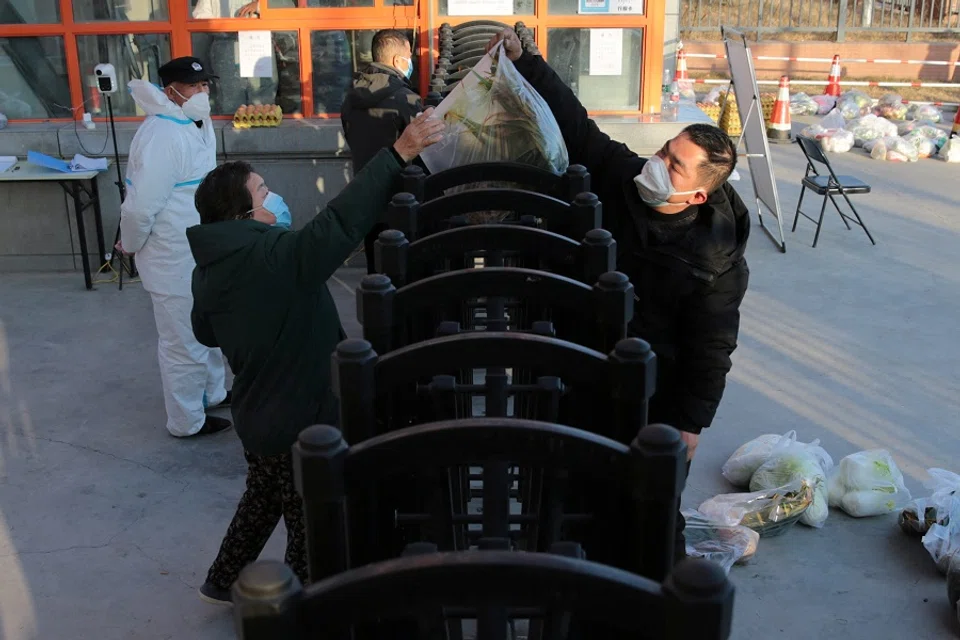Chaos in Xi'an: From zero-Covid to 'zero cases in communities'
In the face of greater challenges in containing Covid-19, China seems to have tweaked its zero-Covid strategy in Xi'an to that of "zero cases in communities". Even so, the situation since a lockdown started on 23 December 2021 seems chaotic. What else needs to change as authorities tailor their approach to different cities and situations? Zaobao correspondent Yang Danxu examines the issue.

Since the pandemic broke out, there have been no direct flights between Singapore and Beijing. Heading back to China after a break in Singapore, I chose a flight to Shanghai without a second thought.
Many friends returning to China from overseas have concluded that Shanghai is the most organised Chinese city in terms of handling people entering the country; it has the most foresight and its quarantine rules are seldom uncertain.
Two years into the pandemic, Shanghai receives a high volume of international flights and is under a greater threat of imported cases than any other city in China. With its precise and scientific approach to pandemic prevention, while there have been some sporadic outbreaks, these were all quickly stamped out with "quick, accurate, precise" measures, and so far there has been no large-scale spread.
Infectious diseases expert Zhang Wenhong has described Shanghai's pandemic efforts as "catching mice in a china shop". This is a vivid analogy of having to be quick in chasing down the virus and taking the necessary precautions, while also having to make sure life goes on as usual. But replicating Shanghai's approaches in other cities in China is not easy.

...the lockdown was implemented without ensuring the "last mile" in delivering everyday supplies, with people lamenting the shortage of food and groceries on social media; a resident was beaten by enforcers for going out to buy steamed buns.
Chaos in Xi'an
On 9 December 2021, Xi'an - the largest city in northwest China - saw a fresh wave of locally transmitted infections. As of 3 January 2022, there are over 1,700 confirmed cases there. With a sharp rise in cases, this city of 13 million people went into lockdown from midnight on 23 December 2021. This is even stricter than the measures for Wuhan early in the pandemic in 2020. However, even with the precedent of Wuhan, the lockdown in Xi'an has still been a figurative train wreck.
The hasty announcement of the lockdown meant that the pandemic control and emergency response teams on the ground could not promptly respond, leading to the recurrence of various chaotic situations that happened in Wuhan.
Some people were shut out of their residential compound in the winter cold and could not go home due to the lockdown; supermarkets saw panic buying; the lockdown was implemented without ensuring the "last mile" in delivering everyday supplies, with people lamenting the shortage of food and groceries on social media; a resident was beaten by enforcers for going out to buy steamed buns.
From Chinese media reports and some residents' online posts, large-scale testing in Xi'an has also been a messy affair. Some residents were woken up in the middle of the night to get tested; some testing locations did not have people maintaining order, as many residents gathered without social distancing - many people were not even wearing masks, sparking the risk of fresh cross-infections.

On 4 January 2022, the "One Code Pass" app - a big data platform for pandemic control - crashed due to heavy user traffic, the second outage in two weeks. The last outage was on 20 December 2021, where many were affected in going out and going to work.
Put simply, as long as all new Covid-19 cases are found in quarantine areas and none are found in non-quarantine areas, "zero cases in communities" would have been achieved.
The logic of 'zero cases in communities'
On a visit to the pandemic control centre in Xi'an to direct pandemic efforts for Chengzhong village on 2 January, Shaanxi party secretary Liu Guozhong said that there was a need to achieve "zero cases in communities" as soon as possible.
An official at Xi'an's disease control authority explained that "zero cases in communities" is the situation where all new infections are found among people already in quarantine, and where the virus is no longer spreading widely throughout the community. Put simply, as long as all new Covid-19 cases are found in quarantine areas and none are found in non-quarantine areas, "zero cases in communities" would have been achieved.
"Zero cases in communities" has its own epidemic prevention logic in that it separates the high-risk group from the low-risk group, and makes epidemic prevention and control more targeted. Once the spread of Covid-19 is contained in a smaller area, other areas can open up in an orderly manner as soon as possible, and life can get back to normal.
Others are worried that grassroots officials would adopt one-size-fits-all epidemic measures just to fulfil the political goal of achieving "zero cases in communities".

However, the goal of achieving "zero cases in communities" has received much flak. Some people think that with the Beijing Winter Olympics and the country's annual Spring Festival travel rush (春运, Chunyun period) fast approaching, Xi'an is under enormous pressure of achieving "zero-Covid" and can only play the numbers game by achieving "zero cases in communities" instead, hoping that it will do the trick. Others are worried that grassroots officials would adopt one-size-fits-all epidemic measures just to fulfil the political goal of achieving "zero cases in communities". For example, as long as one resident in a building is found to be infected with Covid-19, they may request all residents to be transferred to hotels or other facilities for mandatory quarantine.
While these questions and worries stem from people's anxiety following the sudden outbreak, they also reflect Xi'an residents' lack of confidence in the local authorities. From the time that Xi'an's lockdown started, disorganised investigations have yet to yield any leads on the source of the outbreak. Judging by the elementary, crude and absurd measures that have been implemented after the lockdown, these questions and worries are not unfounded.
The messy situation in Xi'an also shows uneven governance across China and huge differences in epidemic control capabilities.

China has amassed two years of experience in fighting the pandemic since the Wuhan outbreak in early 2020. During this period, the country has achieved outstanding results in pandemic containment and can even be called a "model student". However, the messy situation in Xi'an also shows uneven governance across China and huge differences in epidemic control capabilities. With this latest outbreak, China's ability as a whole to emerge from the pandemic is called into question again.
This is also the challenge and dilemma China faces. As most countries work towards living with the virus, China still insists on the stressful zero-Covid policy. However, faced with questions and doubts, China may not have the confidence to work towards living with the virus either. The Covid-19 pandemic is an ongoing test of endurance; reopening borders is the direction that the world is headed. At the same time, the greater transmissibility of the Omicron variant has created greater challenges for reopening. Under the ever-changing situation, China may need to offer new answers.
Related: China's zero-Covid regime: My home quarantine experience in Beijing | When Beijingers can't return home: Is China going overboard with its zero-Covid measures? | Singapore health experts: China the best positioned country to aim for zero-Covid | Why China is determined to achieve 'zero-Covid' | Is China taking policies to the extreme to achieve zero-Covid? | China has a zero-Covid policy. Can it pull off a spectacular Winter Olympics?



![[Photos] Fact versus fiction: The portrayal of WWII anti-Japanese martyrs in Taiwan](https://cassette.sphdigital.com.sg/image/thinkchina/3494f8bd481870f7c65b881fd21a3fd733f573f23232376e39c532a2c7593cbc)

